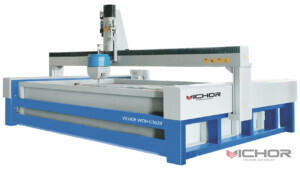
Small CNC Waterjet: Enhancing Precision and Efficiency in Modern Fabrication
In today’s fast-paced manufacturing and prototyping world, the demand for versatile and precise cutting tools has never been higher. Among these, the small CNC waterjet has emerged as a game-changer, offering unparalleled accuracy and flexibility for a wide range of applications. This compact yet powerful machine leverages advanced technology to cut through various materials with ease, making it an ideal choice for small businesses, hobbyists, and educational institutions. In this article, we will delve into the intricacies of the small CNC waterjet, exploring its core aspects to help you understand why it’s becoming an indispensable tool in modern workshops. From its fundamental workings to its practical benefits, we’ll cover everything you need to know about this innovative equipment.
What is a Small CNC Waterjet?
A small CNC waterjet is a computer-numerically-controlled (CNC) machine that utilizes a high-pressure stream of water, often mixed with abrasive substances, to cut materials with extreme precision. Unlike traditional cutting methods, this system relies on the force of water accelerated to supersonic speeds, enabling it to slice through metals, ceramics, composites, and even delicate materials like glass without generating heat-affected zones. The “small” designation typically refers to its compact size, making it suitable for limited spaces such as small workshops, labs, or on-site job locations. These machines are designed for efficiency, allowing users to perform intricate cuts with minimal waste. The integration of CNC technology ensures that operations are automated, repeatable, and highly accurate, driven by digital designs. This combination of size and capability makes the small CNC waterjet a versatile solution for those who require high-quality results without the bulk of industrial-scale equipment. As more industries adopt digital fabrication, the small CNC waterjet continues to gain popularity for its ability to handle complex projects with ease.
How Does a Small CNC Waterjet Work?
The operation of a small CNC waterjet involves a sophisticated process that combines hydraulic pressure, abrasive mixing, and computer control. First, a high-pressure pump intensifies water to levels exceeding 60,000 psi, which is then forced through a small nozzle to create a focused jet. In many cases, an abrasive material, such as garnet, is introduced into the stream to enhance cutting power, especially for harder substances. The CNC component plays a crucial role by translating digital designs—often from CAD files—into precise movements of the cutting head along multiple axes. This automation allows the small CNC waterjet to follow complex patterns with tolerances as tight as a few thousandths of an inch. Key components include the intensifier pump, abrasive delivery system, and control software, all optimized for compact setups. Unlike thermal cutting methods, the small CNC waterjet produces no heat, preventing material distortion and preserving the integrity of sensitive substrates. This cold-cutting process is one of the main reasons why the small CNC waterjet is favored for applications where precision and material preservation are paramount. By understanding this workflow, users can appreciate the engineering behind the machine’s efficiency and reliability.
Applications of Small CNC Waterjet
The small CNC waterjet finds utility across a diverse array of industries due to its adaptability and precision. In the automotive sector, it is used for cutting custom parts, gaskets, and lightweight composites, enabling rapid prototyping and small-batch production. Aerospace applications include fabricating intricate components from titanium or aluminum alloys, where the small CNC waterjet ensures minimal material stress. Art and design communities leverage this tool for creating detailed sculptures, jewelry, and architectural elements from materials like stone or acrylic, thanks to its ability to handle delicate cuts. Additionally, the small CNC waterjet is invaluable in electronics for producing precise circuit boards and enclosures without causing thermal damage. Educational institutions incorporate it into STEM programs to teach students about advanced manufacturing techniques, while small-scale manufacturers use it for on-demand production runs. The medical field also benefits, with the small CNC waterjet employed in crafting surgical instruments and implants from biocompatible materials. This wide-ranging applicability underscores the machine’s versatility, making the small CNC waterjet a go-to solution for projects that demand accuracy and flexibility in a compact form factor.
Advantages of Using a Small CNC Waterjet
One of the primary benefits of a small CNC waterjet is its ability to cut virtually any material without thermal distortion, which is a common issue with lasers or plasma cutters. This cold-cutting process preserves material properties, reducing waste and improving finish quality. The precision offered by a small CNC waterjet is exceptional, allowing for intricate designs and tight tolerances that are difficult to achieve with manual methods. Moreover, these machines are highly efficient, with automated operations that minimize labor costs and increase throughput. The compact size of a small CNC waterjet makes it accessible for smaller spaces, lowering the barrier to entry for startups and individual entrepreneurs. Environmentally, the small CNC waterjet is often considered greener than alternatives, as it typically uses water and natural abrasives, reducing hazardous emissions. Flexibility is another key advantage; users can quickly switch between materials and designs without extensive retooling. This adaptability, combined with the reliability of CNC technology, means that a small CNC waterjet can handle both one-off projects and repetitive tasks with consistent results. Overall, investing in a small CNC waterjet can lead to significant cost savings and enhanced productivity over time.
Limitations and Challenges of Small CNC Waterjet
Despite its many strengths, the small CNC waterjet does have some limitations that users should consider. The initial investment can be relatively high, including costs for the machine, installation, and maintenance, which might be prohibitive for very small budgets. Operating expenses, such as abrasive consumption and pump maintenance, can add up over time, impacting the total cost of ownership. The cutting speed of a small CNC waterjet may be slower compared to thermal methods for certain materials, which could affect project timelines in high-volume settings. Noise and water management are practical challenges; these machines can generate significant sound levels and require proper filtration systems to handle wastewater containing abrasives and material particles. Additionally, achieving optimal results with a small CNC waterjet demands skilled operation and regular calibration, which might involve a learning curve for newcomers. However, many of these issues can be mitigated with proper planning and training. By weighing these factors against the benefits, potential users can make informed decisions about integrating a small CNC waterjet into their workflows.

How to Choose the Right Small CNC Waterjet
Selecting the appropriate small CNC waterjet involves evaluating several factors to match your specific needs. First, consider the materials you’ll be cutting most frequently, as this will influence the required pressure levels and abrasive options. For instance, softer materials might not need abrasives, while harder ones do. Next, assess the machine’s size and footprint to ensure it fits in your workspace; a small CNC waterjet should offer a balance between capability and space efficiency. Look at the CNC software compatibility—user-friendly interfaces and support for common file formats can streamline operations. Durability and after-sales support are critical; opt for models with robust construction and accessible service networks to minimize downtime. Budget is another key aspect; while a small CNC waterjet can be a significant investment, consider long-term value in terms of maintenance costs and productivity gains. Finally, read reviews and seek demonstrations to gauge performance in real-world scenarios. By taking a methodical approach, you can find a small CNC waterjet that enhances your fabrication capabilities without unnecessary complexities.
In conclusion, the small CNC waterjet represents a significant advancement in cutting technology, offering precision, versatility, and efficiency in a compact package. Whether for industrial applications or creative endeavors, this machine empowers users to achieve high-quality results with minimal environmental impact. As technology evolves, the small CNC waterjet is poised to become even more accessible and capable, driving innovation across various fields.
Frequently Asked Questions
Q1: What materials can a small CNC waterjet cut?
A1: A small CNC waterjet can cut a wide range of materials, including metals like steel and aluminum, ceramics, glass, stone, plastics, composites, and even rubber. Its cold-cutting process prevents heat damage, making it suitable for sensitive materials.
Q2: How much does a small CNC waterjet typically cost?
A2: The cost of a small CNC waterjet varies based on features and specifications, but generally ranges from $50,000 to $150,000. This includes basic setup, but additional expenses for maintenance, abrasives, and installation should be factored in.
Q3: Is specialized training required to operate a small CNC waterjet?
A3: Yes, operating a small CNC waterjet typically requires training in CNC programming, machine maintenance, and safety procedures. Many suppliers offer training programs, and familiarity with CAD software is beneficial for optimal use.
Q4: What maintenance is needed for a small CNC waterjet?
A4: Regular maintenance for a small CNC waterjet includes checking and replacing the high-pressure pump seals, inspecting nozzles for wear, cleaning the abrasive delivery system, and ensuring the water filtration system is functional to prevent clogs and damage.
Q5: Can a small CNC waterjet be used for 3D cutting or beveling?
A5: While a standard small CNC waterjet is primarily designed for 2D cutting, some advanced models with multi-axis capabilities can perform 3D cuts and beveling. However, this may require additional accessories and software, so it’s important to verify the machine’s specifications before purchase.
continue reading
Related Posts
- 1155 words5.8 min read

